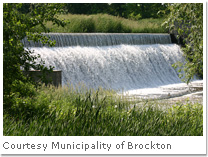Determine the approximate time that bacteria began to enter the water supply, and investigate any unusual events around that time

By looking at the dates on which people fell ill, and allowing for the usual time lag between exposure to E. coli O157:H7 and the development of symptoms, it seems likely that most residents of Walkerton drank contaminated water from May 13 to May 16. The bacteria probably first entered the water system on May 12.
Did anything unusual happen around May 12 that might have caused one of the town's wells to become contaminated? Yes; it had rained heavily for five days, most heavily on May 12.
As we know, the town has three wells. Unfortunately, the one most frequently in use from May 12 to May 16 was Well 5, the shallowest of the wells and the one most vulnerable to having run-off from the surface reach its water.
E. coli O157:H7 and the other bacteria found in Walkerton's water are most often associated with cattle and cattle manure. Was there any way that cattle manure could have been washed into the water of Well 5? Investigators discover that the fields around the well had been heavily dressed with cattle manure in late April to fertilize them.
It is now clear how and where the bacteria entered the water system. But why did modern water treatment fail to disinfect the water before it came out of people's taps?


